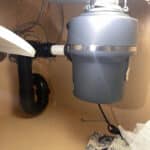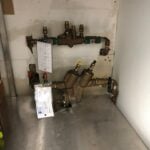Horizontal Directional Drilling (HDD) in Toronto and GTA area
 HDD stands for Horizontal Directional Drilling.
HDD stands for Horizontal Directional Drilling.
Anta Plumbing Directional Drilling
It is a trenchless method of installing underground utilities, such as pipes, conduits, and cables, without requiring extensive excavation. HDD involves drilling a pilot hole horizontally beneath the ground surface and then enlarging it to accommodate the desired utility.
Here's how HDD works:
1. Pilot hole drilling: A small-diameter pilot hole is drilled horizontally underground using a directional drilling rig. The drill rig is typically set up at the entry point, and the drill string with a cutting tool, known as a drill bit, is inserted into the ground. The drilling process is guided by specialized equipment that allows for precise control of the direction and depth of the hole.
2. Hole enlargement: After the pilot hole is drilled, the drill string is removed, and an enormous cutting tool, known as a reamer, is attached. The reamer is pulled back through the pilot hole, enlarging it to the desired diameter. This process may be performed in multiple passes, gradually increasing the size of the hole.
3. Utility installation: Once the hole is enlarged, the utility, such as a pipe or conduit, is attached to the drill string and pulled back through the hole. The drilling rig applies the necessary force to pull the utility into place as the reamer is gradually withdrawn.
4. Backfilling and restoration: After the utility is installed, the hole is backfilled with suitable materials, such as drilling fluid, bentonite, or a combination of soil and grout. The surface is then restored to its original condition, minimizing the disruption to the surrounding area.
HDD offers several advantages over traditional open-cut excavation methods:
1. Minimizes disruption: HDD eliminates the need for extensive excavation, reducing disruption to the surface, roadways, landscaping, and existing infrastructure. This is especially beneficial in urban areas or environmentally sensitive locations where open-cut excavation may not be feasible or desirable.
2. Cost-effective: HDD can be more cost-effective than traditional excavation methods, requiring less labour, restoration, and post-installation repairs. It also reduces the need for traffic control and permits associated with open-cut construction.
3. Increased installation flexibility: HDD allows installing utilities at various depths and angles, including beneath obstacles like rivers, highways, and structures. It provides greater flexibility in designing and routing underground infrastructure.
4. Reduced environmental impact: By minimizing excavation, HDD helps preserve natural habitats, reduces vegetation disturbance, and minimizes soil erosion. It also decreases the potential for groundwater contamination and protects sensitive ecosystems.
HDD is commonly used to install utilities like water and sewer lines, telecommunications and fibre optic cables, gas and oil pipelines, electrical conduits, etc. Its versatility, efficiency, and minimal disruption make it a preferred method for underground utility installations in many applications.


